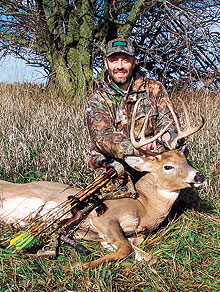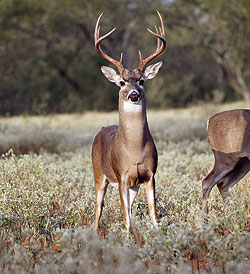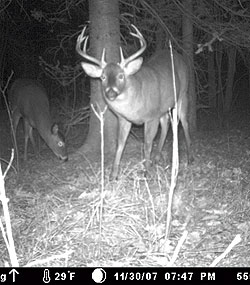November 04, 2010
Why travel to distant places when the best whitetail hunting might lie right outside your own back door?
By Bob Humphrey

Advertisement
Hunting close to home allows you to pick your days, waiting until conditions are most favorable to cash in some of your valuable hunting time. |
Advertisement
I almost didn't hunt that afternoon. Temperatures were soaring into the high 70s, not unusual for late September but not productive for bowhunting. Besides, I had plenty of work to do. Better to wait for a cooler evening, I rationalized. Then, at the last moment, I had a change of heart, a combination of Ah, what the heck? and intuition.
I took a quick shower, threw on shorts and a T-shirt, and grabbed my bow. Everything else was where it lives at that time of year -- in airtight containers in my truck. Fifteen minutes later I pulled up to the end of a cul-de-sac, parked, changed into my hunting togs, and hit the woods. In less than 30 minutes, I was perched and hunting.
As expected, the first half-hour passed uneventfully. The air was muggy, and sweat beaded on my face. Regretting my decision, I wished for darkness to hurry and end my hunt.
As the shadows lengthened, however, I sensed the air starting to cool ever so slightly.
Fifteen more minutes passed. I could still see blue sky, but under the canopy of big white pines light was fading fast. I glanced at my watch again -- 10 minutes left. Then, I heard hooves in leaves. They were not the delicate footsteps of a doe easing from her bedding area; they were far more deliberate. A shadow moved in the dense honeysuckle, and then I saw a patch of brown, a glint of antler, and a heavy beam. With a clear shot at his vitals, I released an arrow and recovered the deer less than 100 yards from my stand and scarcely 200 from my truck.
As recently as 20 years ago most hunters had to travel considerable distances to find quality deer hunting, but that's no longer the case. Now, healthy deer populations -- sometimes too healthy -- including some great bucks, are commonplace in and around the suburbs. For quality deer hunting these days, look no farther than your backyard -- or your neighbor's.
William Faulkner wrote, "All any man has is time." Maybe so, but nowadays we all seem to have too little of it, particularly when it comes to hunting, which brings up a major advantage of hunting close to home -- you can spend a lot more time on stand and much less time traveling.
Instead of one week of vacation and a few Saturdays, you might be able to hunt every day. Before my wife and I had kids, I hunted six days a week, slipping out for a couple of hours in the morning, putting in a full day's work, and then hunting the last couple of hours of daylight. I would have hunted seven days, but the unenlightened folks in Maine insist on preserving 17th Century blue laws -- specifically a prohibition on Sunday hunting.
Hunting close to home, you will spend more time in a particular area. The more familiar you become with a spot, the more you learn about the deer that inhabit it, and over time you'll begin to recognize patterns you can exploit. Just be careful not to overhunt any one place (more on that in a bit).
Hunting locally, you have the luxury of being able to pick your days. On any hunt far from home, you have a set time, say five days, to hunt whether rain or shine, hot or cold.
Near home, you can wait for the right conditions. If it's rainy or windy, you might stay home to catch up on chores or put in a few extra hours at work. Then, when the sun shines and the wind is right, you can slip out early and not feel guilty -- or catch the ire of your boss.

Suburban deer may stand and watch as children play and people walk their dogs nearby. But enter their domain and you'll soon learn that they may be more wary than their wilderness brethren. |
Further, you can focus on peak times. On a five-day hunt you may hunt 10 hours a day for five days. That's 50 hours of hunting. However, probably less than half of that would be considered quality hunting time. Take those 50 hours back home and distribute them over the first and last two hours of the day, and you've more than doubled your effective hunting days -- and raised the odds for success exponentially.
At home you can hunt the way you want to hunt. I'm fortunate in being able to travel to hunt, but that's sometimes a double-edged sword. I'm sitting in someone else's stand, which means I must have complete confidence in their ability to scout, learn patterns, hang stands appropriately, and place me in the right spot at the right time. That's a huge leap of faith.
A few years ago I was bowhunting near Montana's Powder River, where the whitetails were visiting alfalfa fields in the evenings. Over the first four days, I observed deer and continued to alter my stand location until I had bucks close -- but not quite close enough.
I needed one more day and a little refining to put myself in exactly the right spot.
Unfortunately, I was out of time and had to leave, just when I felt confident I had the deer figured out.
On a backyard hunt, that probably would not happen. Hunting near home, you can take your time, learn the local patterns, and stay up to date on what the deer are doing from one day to the next, or one week to the next, even from season to season. You can be more patient. Hunting away from home on a limited time budget, you tend to be hastier in playing the best hands. Back home, you can hold your best cards until they'll do you the most good.
One of the biggest mistakes bowhunters make is to burn-out their prime stands before conditions are right. Some stands are best used only during certain periods, like the rut. If you know this -- something you may be able to learn only by hunting the same area year after year -- and have the time, you can save those special places for the opportune moment.
It's hard to generalize about how to hunt backyard deer because tactics will vary considerably, depending on circumstances. Still, a few generalities apply everywhere.
Early on, you might have a tendency to overuse stands because they're so conveniently located. Don't. I try not to hunt the same stand two days in a row, or more than three times a week. That way I can keep them all fresh. Incidentally, hunting close to home gives you more time to scout and hang more stands. Thus, over time you'll be less inclined to ov
erhunt any particular one.
That brings up another important point: Often, backyard stands are literally in backyards -- densely developed suburban settings where the deer seem almost tame. Don't be fooled. Those deer are every bit as wary as their country cousins, if not more wary. Yes, they become accustomed to and tolerant of human routines, but step off the mowed lawn and into the deers' domain, and they instantly go on red alert. As a result, you must be extra careful to minimize your scent and disturbance.
Two of my best backyard bow stands are within sight of trails routinely used by dog walkers, joggers, and mountain bikers. The cul-de-sac stand mentioned in the opening passage sits within 200 yards of my parking area. However, I use one of three different approach routes, depending on wind direction and time of day.
Scouting cameras are invaluable for hunting neighborhood deer. You can do a lot of in-depth scouting while minimizing your visits and disturbance in a given area.

Scouting cameras are particularly valuable for close-to-home hunting. You can gather information with little disturbance to the woods, and you can observe deer over an extended period of time to form a long-term hunting strategy. |
One obvious downside to hunting among people is potential conflicts. Nonhunters aren't much of a problem as long as they stick to their routines. A bigger potential problem is other hunters. I hunt a 50-acre woodlot surrounded by houses, and I can always tell when someone else has been in there. Deer movement shuts down for a day or two.
If you have exclusive hunting permission, you're golden. If not, you may want to work out an arrangement with the other hunters on the property. Maybe they hunt Mondays and Wednesdays and you hunt Tuesdays and Thursdays. You could tell each other where you're hunting and agree to stay away from one another, although that could backfire if they fail to honor the agreement. Or, you could study the competition and try to use their activity to your advantage. Get in the woods before them and set up on escape routes, or hunt security cover.
Some places are inherently better than others. All deer will concentrate where their needs of food, water, and cover occur in closest proximity. In particular, suburban deer will stick to heavy cover as they travel during daylight hours. Look for funnels like narrow strips of woods between houses and between larger blocks of forest.
Many backyard areas are off-limits to all hunters, and these are essentially little refuges where bucks can reach maturity. Never overlook the potential for hunting adjacent to such areas. Deer don't recognize boundaries, and even the wariest bucks will occasionally wander next door, particularly during the rut.
Obviously, most backyard hunts will take place on private property. Once you have secured permission, be a friend to the landowner. Keep your eyes and ears open and report anything you see that looks out of place. Be prepared to follow any extra conditions they may apply, such as being discreet or possibly field-dressing deer off-site.
And, by all means, be extra careful with shot placement. You want deer to drop where you can retrieve them without making a scene.
One of my most memorable hunts took place during the very late season in a small beachfront community of mostly summer cottages. Residents there were fed up with decimated landscaping and an exceptionally high incidence of Lyme disease, prompting them to demand the state do something. Having worked there in the past, I got together with the regional biologist and the state bowhunting organization, and we worked out a plan for a controlled hunt.
My first afternoon, I sat and watched deer file by 80 yards away. The second afternoon I moved in closer, but the wind required me to go past where I wanted to be, and deer filed by just out of bow range.
On the third afternoon I hit it just right. A big doe skulked through the alders heading toward her normal afternoon feeding spot, the back lawn of an unoccupied summer home. When she stopped just short of open lawn, I sent an arrow through her chest. She ran in a wide arc past the tennis court, around the swing set, and back into the woods, where she expired 50 feet from the neighbor's deck. Watching the commotion from the comfort of his warm home, one of the neighbors stuck his head out the back door and yelled, "Way to go!"
Sure, I like to travel to hunt whitetail deer and will continue to do so. But for the most productive hunting, I'm convinced there's really no place like home.
The author is an outdoor writer and wildlife biologist from Pownal, Maine.

